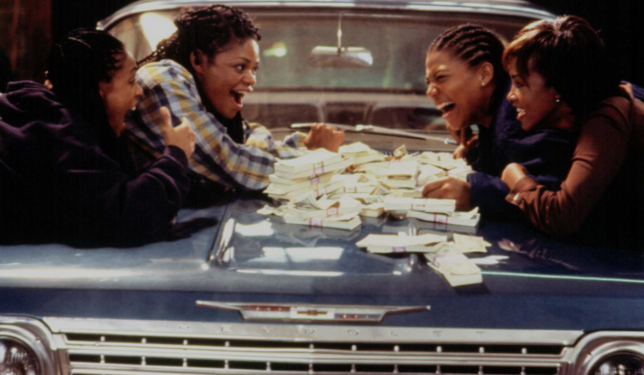The social process theory that best explains Frankie’s decision to commit bank robbery is Travis’ Hirschi’s Social Bond Theory. According to Hirschi there are four elements to the social bond: commitment, attachment, involvement, and belief. At the beginning of the movie, Frabnmkie demonstrates commitment, working at her job that she loves. It didn’t seem that she would want to mess up her job by committing a crime. However, she is fired from this job for simply knowing Darnell. Getting fired ended her commitment to her job and she no longer has anything to lose. The reason that she is fired also affects her belief. This can be seen in how she says they’d be stealing from the system that has been keeping them down. There is no evidence in the movie that Frankie feels any attachment or emotional bonds other than with her three friends, Cleo, Stoya and T.T. There is also a mention of her having any family that would be disappointed by her commission of a crime. The fourth element, involvement, is harder to apply to adults.
According to the textbook: Involvement is engaging in conventional activity such as babysitting or school sports. The more heavily one is involved in conventional activities, such as babysitting or school sports. Though more heavily and is involved in conventional activities, the less time there is available to engage in deviant behavior(Vito, p. 172). Hirschi’s focus appears to be on high school aged teens. Still, while it may not be as applicable to an adult, Frankie does not appear to be involved in any community organizations or clubs. Robert Sampson and John Laub expanded on Hirschi’s social bond theory to include adult social bonds. They found that “martial attachment and job stability predicted distance from crime among adults( Vito, p. 176). As previously mentioned, Frankie was fired from her job at the bank. She now works at a job that she does not value anymore. It does not appear that Frankie is married or has any romantic partner. Social Bond Theory is also the best explanation for Stoney’s willingness to rob the banks. Besides her three friends, Stoney’s attachment to her brother. We have learned that her parents are dead and Stoney doesn’t appear to have any major commitments beyond ensuring that Stevie has a good future.

She has a low paying job that, as Stevie points out, is barely enough to pay the rent. When she tries to get a higher paying job selling cars, Hate takes advantage of her situation. Stevie’s death at the hands of police removes both her attachment and her commitment. Like Frankie, this one traumatic event destroys her belief in society and respect for the laws. Although Stoney does begin a romantic relationship with Keith, this bind comes from her decision to rob the first bank. Cleo’s decision to rob the bank seems to be due to a mix of two informal social control theories: Hirschi’s Social Bond Theory, and Gottfredson and Hirschi’s General Theory of Crime. Each of the four elements of social bond seem to be missing fir Cleo. She does have an attachment to her girlfriend, Ursula. However, Ursula appears to have no problem with Cleo’s commission of crime. There is no evidence that she has any family. Cleo has a job that she does not value. After the first robbery, Cleo simply stops going to work until she runs out of money. It also appears that she is lacking in belief. She does not seem to have respect for that law or sensitivity to the rights of others. This is shown by her criminal past. Cleo reminds Sam that she used to steal cars from him and Detective Strode says that Cleo has priors. Cleo also demonstrates the low self-control that is key to Gottfredson and Hirschi’s General Theory of crime. When the women are planning the first bank robbery, Cleo wants to stop planning and just go rob the bank.
After the robbery, she carelessly celebrates by shooting her gun indoors. She immediately spends all of her cut by fixing up her car, buying booze and drugs, as well as clothes for her girlfriend When Stony criticizes this behavior, Cleo puts a gun to her head. Every time Cleo steals a car, she wastes time throwing CDs out the windows, which also shows her insensitivity. During the second bank robbery, Cleo needs to steal a second getaway car, but she crashes through the wall of the bank and it’s only by; luck that she doesn’t run over her friends. These behaviors are all reflected in the Textbook’s Figure 7-5(Vito, p. 174). Perhaps because T.T is the only one of the girls with an immediate need for the money from the robbery, it is less obvious but Hirschi’s Social Bond Theory is still the best explanation, among social process theories, for her decision to rob a bank. T.T’s main attachment is her son. There is no mention of the son, father and he appear to not be in the picture. There is also no mention of any other family for T.T. Like the other women, she does not appear to value her job, and it does not provide enough money for her to babysitter. Although the threat of losing custody of her son is what drives her to crime, it is not clear if she has lost ha=er belief in society and laws as a whole. T.T even has a positive interaction with Ms. Wells of CPS before the third robbery. For T.T, it appears that she has some of the elements of the social bond, but they are not strong enough to overcome the need for immediate cash.